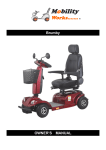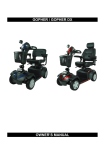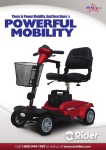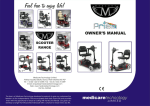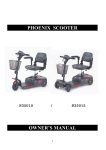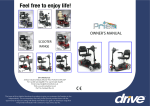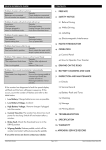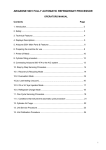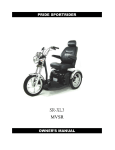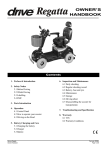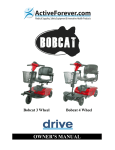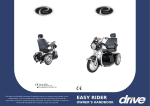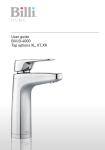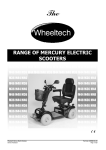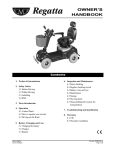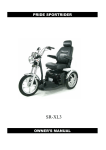Download User manual - Ronica Trade
Transcript
Mobility Works……. Flamingo OWNER’S MANUAL ® TABLE OF CONTENTS 1. PREFACE …………………………………………………………………………………………… 2 2. SAFETY NOTICE …………………………………………………………………………………… 2.1 Before Driving 2.2 Whilst Driving 2.3 Labeling 2.4 Electromagnetic Interference 4 3. PARTS INTRODUCTION ………………………………………………………………………… 10 4. OPERATION ……………………………………………………………………………………… 4.1 Control Panel 4.2 How to Operate Your Scooter 11 5. DRIVING ON THE ROAD ………………………………………………………………………… 6. BATTERY CHARGING AND CARE ……………………………………………………………… 6.1 Charging the Battery 6.2 Charger 6.3 Battery 7. INSPECTION AND MAINTENANCE ……………………………………………… 7.1 Daily Checking 7.2 Regular Checking Record 7.3 Battery, Fuse and Tyre 7.4 Maintenance 7.5 Storage 7.6 Moving About 8. TROUBLESHOOTING ………………………………………………………………… 9. SPECIFICATION……………………………………………………………………………… 25 10.WARRANTY …………………………………………………………………………………… 26 1.PREFACE AND INTRODUCTION Please carefully read this owner’s manual before using the vehicle. Improper use of the vehicle could result in harm, injury or traffic accidents. To ensure that you get the most from your scooter, please read this owners manual before using. This owner’s manual includes operation instructions for every aspect of the vehicle and instructions for how to deal with possible incidents. The symbols used in this manual are explained overleaf: Warning: Improper use could result in serious injury. Attention: Improper use could lead to injury and/or damage to your scooter. Suggestion: Follow these instructions to keep your vehicle in good working order. This manual includes a repair and maintenance record chart and warranty information. Please keep it in a safe place or with the scooter. If someone else uses the scooter make sure that you provide him or her with this owner’s handbook for his or her consideration. As designs change some illustrations and pictures in the manual may not correspond to the vehicle that you purchased. We reserve the right to make design modifications. The Flamingo is lightweight scooter designed and manufactured to provide a solution for some mobility requirements, they are very easy manoeuvre and suitable for indoor and outdoor applications. They are available in colours Burgundy, Blue & Silver Grey 2. SAFETY NOTICE 2.1 BEFORE DRIVING The user needs to be familiar with the use and operation of this vehicle before driving. Therefore, please follow the recommendations in this safety notice. The same traffic rules apply to the user of this vehicle as apply to pedestrians. For your safety, please follow and adhere to the same traffic laws as pedestrians. Ride on the pavement and pedestrian areas only. Never ride on roadways, highways or dual carriageways. Only use roads to cross to the other side of the pavement. Be aware of traffic when crossing any roadway. Be extremely cautious when driving your scooter in busy areas or in shopping malls. Please do not drive your scooter after consuming alcohol, drugs or when you are tired. Please be careful when driving your scooter in low light. It has not been designed for use at night. Practice operating your vehicle Before using the scooter in busy or potentially dangerous areas, familiarize yourself with the operation of your scooter. Practice in a wide and open area like a park. In order to avoid accidents with your scooter whilst driving, please bear in mind driving motions such as accelerating, stopping, turning, reversing, and gradients. Please turn the speed dial to the minimum value for your initial practice. Be sure someone accompanies you for safety when driving for the first time. Only use higher speed settings when you are confident that you can easily operate & control your scooter. ■ The scooter is only to be used by one person at a time Do not carry passengers on your scooter (including children) at any time. ■ Do not use this vehicle to carry or haul goods The maximum weight that can be carried is 115kg (including occupant and any goods). Refer to “MAX LOAD WEIGHT” in “9. SPECIFICATION” . Maximum loading weight for the front basket is 3kg. 2.2 WHILST DRIVING ■ Do not use your vehicle under the circumstances below. On surfaces that are muddy, gravelly, bumpy, narrow, snowed over, icy, or towpaths very near to canals which not guarded by any fence or hedge. Keep away from places where you might get the wheels stuck. Do not drive at night or when it is raining, snowing, misty, or windy. Do not drive your vehicle in an “S” pattern or make erratic turnings. Do not take the scooter onto escalators. UNDER NO CIRCUMSTANCES SHOULD THE SCOOTER BE USED AS A SEAT IN A MOTOR VEHICLE (E.G. CARS, BUSES, TRAINS, ETC). ■ About Mobile Phones and other electrical equipment Do not use a mobile phone or other wireless communication devices whilst driving. Always switch off the scooter and remove the ignition key before using a mobile phone. Do not charge the mobile phone or any other electrical devices from your scooter’s battery. ■ Automatic Power Shut Down In order to avoid accidental battery run down, your scooter is equipped with an automatic power shut down facility. If the scooter is switched on, but remains undisturbed for a period of thirty minutes it will automatically turn off. Should this occur, simply switch your scooter off and back on and it will be ready to use once again. ■ Ramps, gradients and drops Always use a low speed setting when ascending or descending a gradient. Do not drive on paved areas with large drops or potholes. Do not cross water gutters where the width is too big and where there is a risk of getting the wheels stuck. Please slow down when driving on footpaths with gradients. Do not make sudden turns when driving on gravel footpaths or gradients. Always lean forward when climbing a steep gradient WARNING: Do not set in freewheel mode when driving on a gradient. Always re-engage the freewheel device into drive mode before use. Failure to do so may result in injury. The Maximum User Weight Limit is 115kg. Overloading past the weight limit may lead to damage of your scooter or cause it to malfunction and will endanger your safety. The warranty does not cover this type of damage. 2.3 LABELLING Please carefully read all labels on the scooter before driving it. For future reference, do not remove them. WARNING ● Please carefully read the user’s manual before you firstly drive ● You should obey the traffic rules ● Please don’t exceed the max carrying capacity of 115kg ● Please be careful when you make turning and climbing and be specially cautious in bad weather HOW TO CHARGE BATTERIES ● Please carefully read the user’s manual of charger first ● Turn off the power key ● Plug the AC cord into the outlet supplying 165-260V AC power ● The yellow LED indicator turns on when the charger is in the process ● The green indicator turns on when charging is complete WARNING Please do not synchronously operate the forward and rear accelerating lever. NOTICE ● Please do not insert or pull the plug with wet hands ● Please do not get the scooter near the fire while charging 2.4 Electromagnetic Interference This section of the manual will provide the user with basic information that describes the problems with EMI, known sources of EMI, protective measures either to lessen the possibility or exposure or to minimize the degree of exposure, and suggested action should unexpected or erratic movement occur. Attention: It is very important that you read this information regarding the possible effects of electromagnetic interference on your scooter. 2.4.1 ELECTROMAGNETIC INTERFERENCE (EMI) FROM RADIO WAVE SOURCES Powered scooters may be susceptible to electromagnetic interference (EMI), which is interfering electromagnetic energy (EM) emitted from sources such as radio stations, TV stations, amateur radio (HAM) transmitters, two-way radios, and mobile phones. The interference (from radio wave sources) can cause the powered scooter to release its brakes, move by itself, or move in unintended directions. It can also permanently damage the powered scooter’s control system. The intensity of the interfering EM energy can be measured in volts per metre (V/m). Each powered scooter can resist EMI up to a certain intensity. This is called its “immunity level”. The higher the immunity level, the greater the protection. At this time, current technology is capable of achieving at least a 20 V/m immunity level, which would provide useful protection from the more common sources of radiated EMI. This powered scooter model as shipped, with no further modification, has an immunity level of 20 V/m without any accessories. There are a number of sources of relatively intense electromagnetic fields in the everyday environment. Some of these sources are obvious and easy to avoid. Others are not apparent and exposure is unavoidable. However, we believe that by following the warning listed below, your risk to EMI will be minimized.The sources of radiated EMI can be broadly classified into three types: 1. Hand-held portable transceivers (transmitter-receivers with the antenna mounted directly on the transmitting unit). Examples include: citizens band (CB) radios, “walkie talkies”, security, fire, and police transceivers, mobile telephones and other personal communication devices. Attention: Some mobile telephones and similar devices transmit signals while they are ON, even when not being used. 2. Medium-range mobile transceivers, such as those used in police cars, fire trucks, ambulances and taxis. These usually have the antenna mounted on the outside of the vehicle. 3. Long-range transmitters and transceivers, such as commercial broadcast transmitters (radio and TV broadcast antenna towers) and amateur (HAM) radios. Attention: Other types of hand-held devices, such as cordless phones, laptop computers, AM/FM radios, TV sets, CD player, and cassette players, and small appliances, such as electric shavers and hair dryers, so far as we know, are not likely to cause EMI problems to your scooter. 2.4.2 POWERED SCOOTER ELECTROMAGNETIC INTERFERENCE (EMI) Because EM energy rapidly becomes more intense as one moves closer to the transmitting antenna (source), the EM fields from hand-held radio wave sources (transceivers) are of special concern. It is possible to unintentionally bring high levels of EM energy very close to the control system of the scooter while using these devices. This can affect powered scooter movement and braking. Therefore, the warnings listed below are recommended to prevent possible interference with the control system of the powered scooter. 2.4.3 WARNINGS Electromagnetic interference (EMI) from sources such as radio and TV stations, amateur radio (HAM) transmitters, two-way radios, and mobile phones can affect powered scooters. Following the warnings listed below should reduce the chance of unintended brake release or powered scooter movement which could result in serious injury. 1. Do not operate hand-held transceivers-receivers, such as citizens band (CB) radios, or turn ON personal communication devices, such as mobile phones, while the powered scooter is turned ON; 2. Be aware of nearby transmitters, such as radio or TV stations, and try to avoid coming close to them; 3. If unintended movement or brake release occurs, turn the powered scooter OFF as soon as it is safe; 4. Be aware that adding accessories or components, or modifying the powered scooter , may make it more susceptible to EMI ( Note: There is no easy way to evaluate their effect on the overall immunity of the powered scooter ). 5. Report all incidents of unintended movement or brake release to the powered scooter manufacturer, and note whether there is a source of EMI nearby. 2.4.4 IMPORTANT INFORMATION 1. 20 Volts per Metre (V/m) is a generally achievable and useful immunity level against EMI (the higher the level, the greater the protection); 2. This product has an immunity level of 20 V/m without any accessories connected to it. 3. PARTS INTRODUCTION 13 7 6 1 5 2 8 3 9 10 4 11 12 2 1 7 11 4 Parts Description : 1. Rearview mirror 2. Control panel 3. Freewheel lever 4. Anti-tip wheel 5. Seat 6. Arm rest 7. Seat rotation lever 8. Front basket 9. Tiller adjustment knob 10. Seat post 11. Charger socket 12. Circuit breaker 13. Ignition 4.OPERATION 4.1 CONTROL PANEL 10 11 12 1 2 3 4 9 8 5 7 6 1. Rearview mirror 5. Push 9. Wigwag Paddle 2. Speed control 6. Hazard warning switch 10.Headlight 3. Key Ignition 7. Horn Button 11. LED indicator 4. Right turning light 8. Left turning light 12.H/L speed 4.2 HOW TO OPERATE YOUR SCOOTER Key Ignition The key ignition acts as the power switch for the scooter. To switch the power on, turn the key clockwise in the ignition. The LED indicator should illuminate. To switch the power off, turn the key anticlockwise. The LED indicator should switch off and the key can be removed if required. Speed Dial Turn the speed dial to determine the maximum speed of the scooter. Turn the dial clockwise to increase the speed setting and turn the dial anticlockwise to decrease the speed setting. Moving and Braking Pull the right-hand side of the wigwag paddle forwards with your right hand and the scooter will move forward. Pull the left-hand side of the wigwag paddle forward with your left hand and the scooter will move backward, emitting an audible reversing alarm. To brake, release the wigwag paddle which will return to neutral and activate the electromagnetic brake automatically. This will bring the scooter to a prompt stop. The wigwag paddle allows you to control the speed of the scooter up to a maximum speed determined by the Speed Dial. The further the wigwag paddle is deflected, the faster the scooter will go up to its maximum speed of 12km/h. Horn Button Press the horn button to sound the horn. Release the button to stop the horn. Braking Electromagnetic brake: Release the wigwag paddle completely, and the electromagnetic brake will be activated automatically, and the scooter will stop. Warning: When on a gradient NEVER set the vehicle to the freewheel mode. The electromagnetic brakes will not be applied. This may result in injury. Seat The seat can be rotated and locked in position at 45°intervals .Push the seat adjustment lever forward and swivel the seat. Release the lever, and then continue swiveling the seat until it locks in position. Seat rotation lever Attention: Return the seat to the forward position before driving. 1. 2. 3. 4. Adjusting the Seat Height Remove the seat from your scooter Remove the locking pin (arrowed) Move the chrome seat post to the desired height. Adjust the seat post height so that there is a Pre-drilled hole to reinsert the locking pin. 5. Insert the locking pin and lock. Battery Indicator The battery indicator on the tiller console uses a colour code to indicate the approximate remaining power of your batteries. Green indicates (70-100%) capacity, Yellow a draining charge (20-70%), and Red indicates that an immediate recharge is necessary. RED YELLOW GREEN The remaining power indicated by the battery indicator will vary by the actual driving time incurred and how you drive. Repeated starting, stopping, climbing will consume the power more quickly. Suggestion: 1. You should recharge the batteries after each time the vehicle is used to ensure maximum range. The batteries should be charged up at least once a week even if the scooter is not used. 2. After charging or replacing a new battery, drive the vehicle for 2-3 minutes to make sure the battery capacity is sufficient. 3. In wintertime or in cold conditions, the battery may respond more slowly and the battery range may be reduced. 4. When driving on a gradient, the battery indicator gauge might move up and down. This is a normal phenomenon so please do not worry. 5. Even if the battery is used properly, it is natural for the battery’s capacity to reduce with time, which results in reduced battery range compared to a brand new battery. Therefore, when you find the battery’s range is about only 50% of the range when the batteries were new, it is time to replace the batteries. Please see your dealer about replacement batteries. If you continue to use the old battery when it should be replaced, it could lead to a rapid decline in performance. 6. The battery range will be reduced when driving frequently on a gradient or rough terrain, as this leads to greater consumption of power. 7. The batteries have a twelve-month warranty covering manufacturing defects. This warranty does not cover faults due to incorrect battery recharging. How to Set Freewheel Mode Engaged Mode: Pull the lever up completely and the scooter can be driven by the motor. Freewheel Mode: Push the lever down and the scooter can be moved manually. Warning: Never operate the freewheel lever while seated on the scooter or on an incline. Tiller Adjustment The tiller can be adjusted in to many different positions to suit each driver. The tiller can be adjusted by following the steps below: Step 1: Loosen the knob (as being performed in the photo by the lower hand) so the tiller can move. Step 2: Using the other hand, reposition the tiller as required., then retighten the knob to secure the tiller. 5.DRIVING ON THE ROAD Starting and Driving 1. Make sure the seat is installed properly. 2. Make sure the tiller has been secured properly. 3. Fold down the armrests so you can rest your arms on them. 4. Turn the power switch to “ON”. 5. Check battery indicator to see whether there is enough power for your journey. If you have any doubt about the remaining power, recharge the batteries before departure. 6. Set the speed dial to a position you feel safe and comfortable with. 7. Check the wigwag paddle works correctly. 8. Make sure the electromagnetic brake works correctly. 9. Before driving, ensure it is safe to do so in the environment around you. Attention: 1. Do not push both RH & LH sides of the wigwag paddle simultaneously. This might leave you unable to control your scooter. 2. Do not turn the power switch to OFF whilst driving as this will lead to an emergency stop and possible risk of accident and injury. 3. Do not set to the highest speeds whilst driving indoors. 4. Do not adjust the speed dial whilst driving, a sudden change in speed may cause danger to you and others, and may cause damage to your scooter. 5. Do not place magnetic devices near the scooter controller as this could affect the safe operation of your scooter. The scooter controller is located under the footwell. 6. Do be careful whilst driving in heavy traffic or crowded areas. 7. Whilst reversing the vehicle, beware of people or objects behind you. Stopping 1. Release the wigwag paddle completely. The vehicle will naturally brake and stop. 2. Turn the scooter off at the key ignition. Then pull out the key. Attention: The stopping distance will vary with your forward / reverse speed. Therefore please begin braking as early as you can. When parking your scooter, be sure to park on flat ground and then turn the power to “OFF” before you dismount. Main Circuit Breaker (Reset Button) When the voltage in your scooter’s batteries becomes low or the scooter is heavily strained because of excessive loads or steep inclines, the main circuit breaker may trip to protect the motor and electronics from damage. The arrow shows the location of the circuit breaker on the photograph (see above). Under normal operating conditions the circuit breaker button will be protruding 2mm – 3mm. If the circuit breaker has tripped, the button will be protruding by 7mm. To reset the circuit breaker push the button in and the scooter should function as normal. 6.BATTERY CHARGING AND CARE 6.1 CHARGING THE BATTERY Follow the procedure below step by step: 1. Turn the power switch to (OFF) 2. Plug the charger’s power cord into the mains. 3. Open the charging socket cap on the scooter’s tiller head. Then connect the charger’s round plug to the charging socket. 4. Switch on the plug socket. 5. The chargers LED will illuminate orange to indicate the batteries are charging. The charging duration is about 8 hours. To ensure optimum performance a 12-hour charge is recommended. 6. The orange LED will turn green when charging is complete. 7. Turn off the charger, disconnect the power cord and the round plug from charger socket on the scooter. Suggestion: 1. Do not disconnect the charger cord if charging is not completed. The battery life will be seriously shortened or decayed if the battery is repeatedly used without being fully charged. Therefore be sure to charge the battery fully every time. 2. Always complete the charging until the LED light turns green. NEVER stop charging before the charge is complete. 3. When fully charged, the battery charger will still trickle charge the battery to ensure optimum range and life of the battery. 4. If you do not use your scooter for a long time, it should be charged at least every week to keep the battery in a fully usable condition. 5. The ambient temperature will affect charging time. Charging time will be longer in the winter. 6. After charging, do not leave the charger socket plugged in to the scooter, as this will cause a power drain on the scooter and temporarily reduce its range. 7. The batteries carry a twelve-month manufacturer's warranty. This warranty only covers issues relating to manufacturing faults, and not faults relating to failure to recharge the batteries as instructed above. Attention: Please follow the rules below to avoid accidents while charging. 1. Please use the appointed charger only by us, and recharge the battery to its full capacity every time. You may damage the battery and scooter if you use a charger which is not to the correct specification. 2. Never disassemble or modify the charger. 3. Please charge in a well-ventilated space where there is no direct exposure to the sunlight. Do not charge in surroundings where it is humid or under rainfall and morning dews. 4. Do not charge in temperatures less than -10°C or higher than +50°C as the charger may not work well and the batteries may become damaged. Warning: 1. Keep away from flammable objects while charging as this may lead to fire or battery explosion. 2. Do not smoke while charging as the battery may release hydrogen gas. Always charge your battery in a well-ventilated space. 3. Never connect or disconnect the plug or cord with wet hands whilst charging. Do not connect or disconnect the plug or cord when they are wet, it may lead to electric shock. 6.2 CHARGER The charger supplied by us has an LED which changes colour depending on its status: If the LED is lit ORANGE then the charger is switched on and charging If the LED is lit GREEN then the charger is switched on and has finished the bulk of its charging and the batteries can be used. However, we recommend that you leave the charger charging for a couple of hours after the green LED has lit. This will maintain and probably increase the capacity of your batteries. The LED will also illuminate GREEN if the charger is switched on but not connected to the batteries. Warning: If the charger LED does not illuminate then the charger is faulty. In this event please contact your dealer. 6.3 BATTERY Do not expose the battery to temperatures below – 10°C or above 50°C when charging or storing the vehicle. Being out of the above temperature range can cause the battery either to freeze or over heat. This will damage the batteries and shorten their life. These batteries are maintenance free and there is no need to inspect the battery liquid or refill with water. You are required to recharge the batteries on a regular basis. Even if the scooter is stood idle, you should charge the batteries at least once a week. Warning: Do not open the battery-sealed cap at any time. Batteries Battery specific specifications please refer to 9.SPECIFICATION. They are sealed lead acid type, and are maintenance free and non-spill. They are supplied with spade terminals. Warning: Do not remove the battery pack whilst the scooter is switched (ON). This will cause the scooter to stop and may damage the scooter. If, whilst the scooter is switched on, the battery pack is accidentally removed or loses contact as the result of jolt, switch the scooter (OFF). Then reinsert the battery pack and switch the scooter (ON). Charging the Batteries Using the charger supplied with the scooter, the charging duration is about 8 hours. However, to ensure optimum performance we recommend a 12-hour charge. We also recommend that the batteries are not charged for more than 24 hours. 7.INSPECTION AND MAINTENANCE 7.1 DAILY CHECKING Check the following items before driving. If you find anything abnormal, contact your dealer for further inspection or advice before using the scooter. Item Tiller Speed Control Dial Speed Control Lever Motor Freewheel Mode Battery Indicator Horn Seat Tyres Other Inspection Is there any looseness? Can it turn left and right smoothly ? Can it be adjusted freely and does it function well? Does the scooter move when the lever pressed down? Does the scooter stop when the lever is released completely? Is there an abnormal noise from the motor? Do the electromagnetic brakes work properly? Does the freewheel mode lever work properly? Is the light on when the power is switched on? Is the remaining power enough for your trip? Does the horn work? Can the seat swivel smoothly? Are there any cracks or other damage to the tyres? Check the tyre tread depth and air pressure Are there any abnormal noises? Is there oil leakage from the transmission box? Attention: Go to your dealer for inspection and maintenance if you find anything wrong. 7.2 REGULAR CHECKING RECORD To make sure your scooter is correctly serviced, please regularly check it, if you detect any faulty, please contact your dealer timely. Below check record list (for reference). Suggestion: Even if you do not use the vehicle for a long time it should still be serviced regularly. 7.3 BATTERY, FUSE AND TYRE Battery Refer to the section entitled “6.3 BATTERY” in “6. BATTERY CHARGING AND CARE”. Fuse If the battery charger is turned on and the LED is not lit, check the fuse. Suggestion: Ask for help from your dealer to inspect or replace the fuse, since the tiller shroud has to be removed first before you can replace the fuse. Tyres The condition of the tyres depends on how you drive and use your scooter. Please check the tread depth and air pressure regularly. Replace the tyres when the tread depth is less than 0.5mm. Attention: 1. When tread depth is below 0.5mm it can easily lead to vehicle slippage, making braking distances longer. Therefore replace the tyres as early as possible when they are found to have insufficient tread depth. 2. Check the air pressure of your tyres regulary. 7.4 MAINTENANCE You must maintain the scooter frequently if you tend to drive on grass, sand, and gravel or in other adverse environments. Do not use, water, oil or other chemical solutions to clean your scooter. Be sure NOT to spray the scooter with a hose or tap as this may cause damage to electronic componentry and the scooter controller. Please take the scooter to authorised dealers for repairs and adjustments. Improper adjustments could lead to an accident or scooter malfunction. Please use a soft, wrung dry cloth to keep your scooter tidy and dust-free. Use natural or mild detergent to clean the scooter. Attention: When conducting maintenance of your vehicle, turn the power switch to OFF and remove the charger cords. Suggestions: Do not splash water directly to wash your scooter as this could lead to malfunction of the system electrics. Do not use petrol, solvents or vaporizing solution as these may deform or damage the shrouds. Do not use wax. 7.5 STORAGE Ensure the scooter is stored under the following conditions: Ensure the seat is set in the ‘forward’ position; Ensure the scooter is switched off; Ensure the charger is disconnected when not in use. Suggestion: Please store the scooter in an environment where it is out of direct sunlight or damp. When storing for a long time, charge the battery to full power and then disconnect the battery terminal. For more details contact to your dealer. 7.6 MOVING ABOUT Switch off the power with the ignition key before moving. Always dismount from the scooter before moving. Lift the scooter by the chassis only, Do Not lift the scooters by the bumper or shrouds as this will cause damage to the scooter and may injury you. For your safety, always ask for help if required. You will need two people when moving or lifting the scooter whole. If you are on your own, please disassemble the scooter before lifting. 8.TROUBLESHOOTING If you have trouble with your scooter, you can inspect the following before taking your scooter to the dealer: If you cannot solve the problem, contact your dealer for assistance. Problem Scooter will not switch on Symptom Batteries not connected Rear and front sections not connected Circuit breaker has tripped Scooter will switch on but will not run Flat batteries Charger plugged in Motor in freewheel mode Flat batteries Scooter appears slow Speed setting slow Remedy Check batteries are connected Check connection on front-to-rear loom Push circuit breaker button to restart Check battery power Unplug charger Re-engage the freewheel lever Check battery power and / or recharge Check the speed dial is not set at low The seat moves whilst in use Seat not locked in position Slowly rotate the seat until it drops in to place and is secure The tiller appears loose Tiller adjustment knob loose Involuntary horn sounds There is a fault on the scooter Tighten the tiller adjustment knob Ensure the wigwag paddle is released and switch the scooter on and off Recharge batteries 9.SPECIFICATION Measurement Length*Width*Height 1120*570*920 mm Total weight 98 kg Power 400 w Batter (12V33H) × 2 Charge 24v 4a Front/rear tyre 2.80/2.50-4(pneumatic) 3.00-4(pneumatic) Brake mode Back wheels electromagnetic brake Drive mode Directly by the 2 back wheels Control operation Wigwag paddle Maximum speed Forward / Backward 8km/h 4km/h The actual maximum gradient 12° Cruising range 30km Obstacle climbing ability 30mm Max Load capability 120kg 500W 12km/h 8km/h Remark: The manufacturer reserves the right to modify the specification if necessary. The final specification is subject to the individual scooter you purchase from your dealer. 10.WARRANTY 10.1 VIN (SCOOTER INDENTIFICATION NUMBER) Model: Flamingo To ensure the correct after sales service and warranty service support, please write down the scooter frame number. The frame number is located on the back of the frame (see photo below). Frame number Motor serial Controller 10.2 STATEMENT FOR WARRANTY There is a comprehensive twelve-month warranty from the date on which your new scooter is delivered. About the warranty, please see the Warranty Conditions below. STATEMENT FOR WARRANTY Three-year Limited Warranty: Structural frame components including: platform fork, seat post, and frame. First year: 100% replacement of parts cost Second year: 50% replacement of parts cost Third year: 35% replacement of parts cost One Year Limited Warranty: For one year from the date of purchase, Mobility Works will repair or replace, at our option, to the original purchaser, free of charge, any part found upon examination by an authorized representative of Mobility Works to be defective in material and/or workmanship. The batteries are warranted by Mobility Works for 12 months from date of purchase. Do not return faulty party to Mobility Works without prior consent. All transportation costs and shipping costs are the responsibility of the original purchaser. Mobility Works accepts no responsibility for good not in their charge during transit. Scooters Imported By Mobility Works 15 Carrington Blvd Thomastown VIC 3074 Phone: 1300 23 66 24 www.mobilityworks.net.au Scooter Manufactured By Ningbo Jiahe Special Vehicle Co. Ltd. Ningbo, Zhejang China Sold to Name ________________________________________ Address ________________________________________ ________________________________________ ________________________________________ Date ________________________________________ Model Flamingo Serial No ________________________________________ ( JH02-D4(ZH) ) 500WPG70A33AH
























